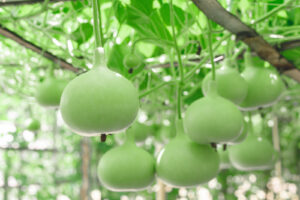In a fascinating dive into the past, a team of researchers from the Boyce Thompson Institute (BTI) and USDA has uncovered intriguing details about the origins and spread of the bottle gourd, one of the oldest domesticated crops. Their research, recently published in New Phytologist, unveils the genetic diversification and population history of this hard-shelled plant that was used to make bottles, instruments, and containers for over 10,000 years by ancient civilizations.

Green bottle gourd
The bottle gourd, known scientifically as Lagenaria siceraria, is a plant deeply intertwined with human civilization. Imagine a plant that voyages across oceans, adapts to new environments, and becomes a staple in diverse cultures. That’s the bottle gourd story.
The research team generated a comprehensive map of bottle gourd’s genome variation, analyzing the genomes of 197 varieties from around the world. This genetic blueprint revealed insights into the plant’s domestication in Southern Africa around 12,000 years ago and its subsequent spread to the Americas and Eurasia.
“Our research not only maps out the genetic journey of the bottle gourd but also opens new avenues for understanding plant domestication and distribution,” said Xuebo Zhao, postdoctoral scientist at BTI and co-first author of the study.
The demographic analyses performed by the researchers suggest that after its origin in Africa, the bottle gourd made its way to the New World via the Atlantic drift and to Eurasia through early human farmers in the Holocene.
The study isn’t just groundbreaking because it unlocks the past. It also offers a resource for future research and a practical tool for agriculture.
“We’re not just piecing together a plant’s story; we’re enhancing our understanding of plant genetics and evolution, gaining insights that could boost food security in a changing world,” shared Jingyin Yu, former BTI postdoctoral scientist and co-first author of the study.
Moreover, the study’s identification of genomic regions associated with disease resistance and stress tolerance is particularly exciting. It suggests potential pathways for breeding more resilient and productive varieties of bottle gourd and other crops.
“The bottle gourd variation map and pangenome that we created provide valuable resources for future functional studies and genomics-assisted breeding,” added Professor Zhangjun Fei, the study’s lead author. “Unlocking the bottle gourd’s past could help shape its future.”
The research underscores the importance of understanding our agricultural heritage as we look toward developing sustainable and resilient food systems for the future.
“The story of the bottle gourd is a testament to the plant’s resilience and its enduring significance to humanity,” noted Fei. “It’s a story that continues to evolve, and we’re just beginning to understand its full implications.”
This research was supported by grants from the USDA National Institute of Food and Agriculture Specialty Crop Research Initiative.
